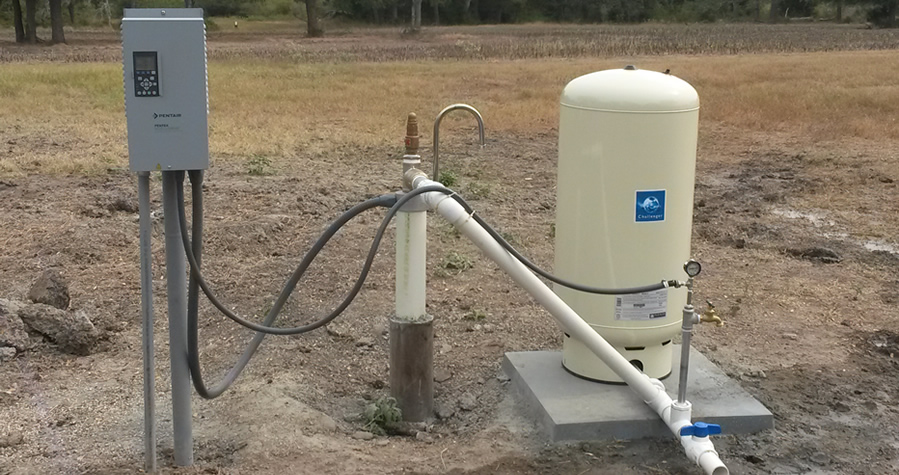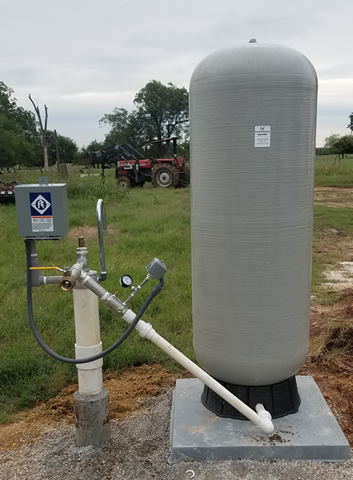
Standard Pressure Water Well System
The basic (Standard Pressure) residential water well system (with a steel sleeve wellhead) looks like the diagram below. The submersible pump pushes water up through the drop pipe to the surface. The check valve keeps water from flowing back into the well. The pressure switch turns the pump on when the pressure drops and off when the pressure builds up. This happens over a 20-psi range usually set on 40 off 60 but this can be adjusted. The pressurized water is stored in the pressure tank – typically 80 or 100 gallons. If the system builds too much pressure, the relief valve will release the excess pressure to prevent the pump from being damaged. If the well produces less water than your water demand over a period of time and the well temporarily runs dry, a Pump Saver device will shut off the pump to protect the pump from overheating and potentially weakening the casing and causing it to collapse.
This has been the tried and true system for generations. It works in almost every situation. But it does have some drawbacks.
If your well produces less water than your demand at any given moment, the Pump Saver will protect the system from damage… but you are still temporarily out of water. Or when the pump finally wears out and needs replaced, you are left without water until the pump can be replaced. In these situations, it is beneficial to have a storage tank system with your well. Click here for information on how a storage tank system can help you.
Another drawback of this standard pressure system is that the pump turns on and off as the pressure in the pressure tank rises and falls by 20 psi range usually set on 40 off 60 but this can be adjusted.. During high usage times (such as long showers or lawn irrigation), this results in a high number of pump starts and stops. These hard starts/stops are what wears pumps out and shortens their lifespan. This 20-psi pressure range can (at best) be frustrating in the shower and (at worst) problematic for your irrigation system since your sprinklers will throw farther/shorter as the pressure rises/falls. This can result in dry/brown spots in your lawn. A solution to all of these problems can be a constant pressure system operated off of a variable frequency drive (VFD).
Constant Pressure Water Well System
 You
can have constant pressure on your private water well system … just like
city water. The pump controller converts single phase 230-volt power to
three phases 230 volt power. It varies the frequency to control the speed of
the pump. This allows the pump to turn at the speed necessary to provide
constant pressure.
You
can have constant pressure on your private water well system … just like
city water. The pump controller converts single phase 230-volt power to
three phases 230 volt power. It varies the frequency to control the speed of
the pump. This allows the pump to turn at the speed necessary to provide
constant pressure.
As flow demand changes, the motor changes speed to maintain a constant pressure. Standard systems vary the pressure by 20 psi same as a conventional setup while this system allows a variance of only 2 psi. There are different models of controllers for each type of pump application. In some cases, the constant pressure system is less expensive than the standard system for the long haul.
A typical constant pressure water well system. The submersible pump pushes water up through the drop pipe to the surface. The check valve keeps water from flowing back into the well. When the pressure in the system drops by 5 psi, a pressure sensor tells the pump controller to turn on the pump.
Then, as described above, the controller varies the speed of the pump to maintain the pressure to within 2 psi of your desired setting (under most conditions). The pressure is stored in a small pressure tank – typically 20 gallons (as opposed to an 84-gallon tank or larger for a basic/standard system). The pump controller is programmed to recognize a variety of conditions that might damage the pump and to temporarily shut off the pump in those situations.
Should the pump controller fail to monitor the pressure and the system builds too much pressure, the relief valve will release the excess pressure.
This system is great for those homeowners who want the assurance of full pressure throughout their showers. It is also beneficial for reverse osmosis (RO) systems. The most common usage of these constant pressure systems is for irrigation. When the pressure varies in the basic/standard system, so does the distance that your sprinkler heads throw the water.
As a result, you can get dry/brown patches in your lawn. With the constant pressure system, your sprinklers will throw the same distance every time. Another advantage to the constant pressure system is that as long as there is at least a 1 GPM water demand, your pump stays on. With a basic/standard system you pump could cycle on and off hundreds of times during an irrigation cycle. This can shorten the life of your pump by 2-3 years, or more.
Another advantage to the constant pressure system is that when the pump does start/stop, it does so gradually. This too can lengthen the life of your pump.



